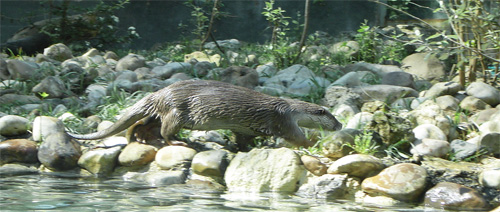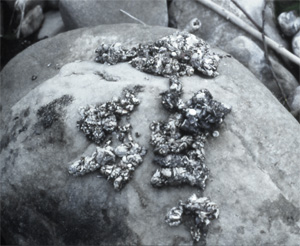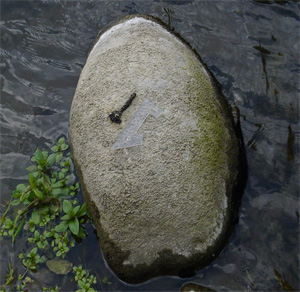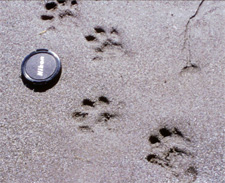 |
 |
 |
The otterby Silvia Sgrosso
One of the most important faunal presence in Grumento Nova area, is certainly the Eurasian otter (Lutra lutra). The otter in Italy is among the most endangered mammals. This species is distributed in Europe, part of Asia, Siberia at mid latitudes and north Africa (Algeria, Morocco and Tunisia). In Europe, the decline was mostly in the central and northern countries, where the process of industrialization was particularly intense, large populations of otter can be found in Greece, Ireland, Portugal, Scotland, and in some Eastern European countries (Prigioni 1999). As for Italy, otter was once certainly present on the whole peninsula, but nowadays its presence is restricted to some southern regions, among them Campania, Basilicata and Calabria host largest populations (Prigioni 1997).
Although the otter is a species difficult to spot, the verification of otter presence is essentially based on the research of its traces, mainly droppings, gel and marks, all of them hallmarks of the species.
The search for signs of life along the bank of rivers is the basis of the study methodology developed by Mason and MacDonald (1986); in that way is possible to evaluate the frequency of positive places and the intensity of marks (expressed as the number of signs for km). We should keep on mind, however, that the intensity of marking varies according to age, sex, social rank or season, and that when the population is not large, the search of signs can be very difficult, since the animals, in absence of competitors, are not stimulated to mark. Several studies conducted in Agri Valley made sure of otter presence along most of the waterways; in reality it is probable that the situation is slowly improving compared to ‘80s, on which are referred the last large-scale studies performed in southern Italy (MacDonald and Mason 1983; Fumagalli and Prigioni 1993; Prigioni 1997). In general, the reduction of pesticide use, a better attention to the type of operations had on waterways and the renaturation of some places that had been compromised, could have given to otter populations the possibility to recover.
|





 The otter is a species strongly embedded to aquatic environments (rivers, streams, irrigation canals, lakes, artificial reserves, marshes and also rocky shorelines such as in Scotland, Ireland and Norway) and tries to find, in particular during breeding season, undisturbed environments and full of rich vegetation. The presence of artificial lake as Pietra del Pertusillo and several rivers (Agri, Sciaura, Maglie) permits that in Grumento Nova area there are several appropriate habitats for the presence of this rare and elusive Mink.
The otter is a species strongly embedded to aquatic environments (rivers, streams, irrigation canals, lakes, artificial reserves, marshes and also rocky shorelines such as in Scotland, Ireland and Norway) and tries to find, in particular during breeding season, undisturbed environments and full of rich vegetation. The presence of artificial lake as Pietra del Pertusillo and several rivers (Agri, Sciaura, Maglie) permits that in Grumento Nova area there are several appropriate habitats for the presence of this rare and elusive Mink. Feces and anal secretions that generally are laid in raised and visible points, are used by otter to mark the boundaries of its territory; the olfactory signal, that is this way can be better spread, communicate to other individuals some information, such as sex, age, social rank occupied by the animal that laid the excrement. At border points of territories the marking activity is more intense, as well as near the holes used for breeding. Usual places of marking are also the confluences of rivers such as the mouth of Sciaura stream into Agri river.
Feces and anal secretions that generally are laid in raised and visible points, are used by otter to mark the boundaries of its territory; the olfactory signal, that is this way can be better spread, communicate to other individuals some information, such as sex, age, social rank occupied by the animal that laid the excrement. At border points of territories the marking activity is more intense, as well as near the holes used for breeding. Usual places of marking are also the confluences of rivers such as the mouth of Sciaura stream into Agri river. Considering that the largest vital populations of otter are those of Campania (Cilento National Park), and of river basins of Basilicata, in particular of Agri and Basento (Loi and Racana 1986; Prigioni 1997; Priore and Sangiuliano 1998), the groups present in Agri Valley have a great importance for their central position and as “connecting bridge” between populations of different areas. In addition there is the role certainly very important of Pertusillo lake both for the stabilization that for the diffusion of otter populations. For this reason it is essential to keep and restore the communication ways between the different areas, through appropriate measures of protection and environmental restoration.
Considering that the largest vital populations of otter are those of Campania (Cilento National Park), and of river basins of Basilicata, in particular of Agri and Basento (Loi and Racana 1986; Prigioni 1997; Priore and Sangiuliano 1998), the groups present in Agri Valley have a great importance for their central position and as “connecting bridge” between populations of different areas. In addition there is the role certainly very important of Pertusillo lake both for the stabilization that for the diffusion of otter populations. For this reason it is essential to keep and restore the communication ways between the different areas, through appropriate measures of protection and environmental restoration.